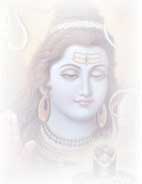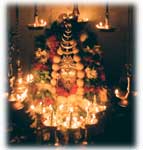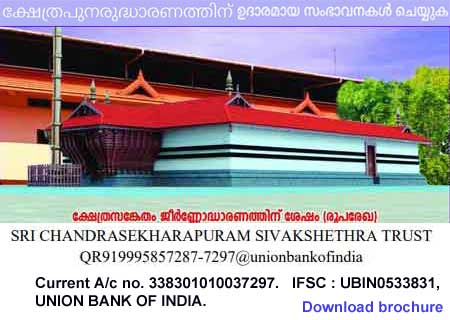
Sadasiva
 The term 'Siva' (Shiva)
is a confluence of two syllables, 'Si' and 'Va', meaning
the 'redeemer of sins' and 'liberator of sufferings'. The Shvetashvetara
Upanishad says, "Siva is minuter than the minutest". He is often considered
to convey a divine dot, a point or seed of cosmic creation, sustenance
and conclusion. In numerical counting, the devout Hindus say 'Siva' instead
of uttering 'one' which points to His position in the universe as the
originator.
The term 'Siva' (Shiva)
is a confluence of two syllables, 'Si' and 'Va', meaning
the 'redeemer of sins' and 'liberator of sufferings'. The Shvetashvetara
Upanishad says, "Siva is minuter than the minutest". He is often considered
to convey a divine dot, a point or seed of cosmic creation, sustenance
and conclusion. In numerical counting, the devout Hindus say 'Siva' instead
of uttering 'one' which points to His position in the universe as the
originator.
At the highest level, lord Siva is SadaSiva, Parameswara, or ParamaSiva. In his formless (nirguna) aspect, A name of the Primal Soul, Siva, a synonym for Parameswara, which is expressed in the physical being of the satguru. He is the end of all spiritual practice, the experience of pure consciousness and bliss in the state of samadhi or union by experiencing which everything is known and realized. SadaSiva especially denotes the power of revealing grace, anugraha shakti, the third tattva, after which emerge Siva's other four divine powers. This five-fold manifestation or expression of God's activity in the cosmos is depicted in Hindu mantras, literature and art as the five-faced SadaSivamurti. These faces are
- Looking upward is Ishana, "ruler" (the power of revealment).
- Facing east is Tatpurusha, "supreme soul" (the power of obscuration).
- Westwardlooking is Sadyojata, "quickly birthing" (the power of creation).
- Northward is Vamadeva, "lovely, pleasing" (the power of preservation).
- Southward is Aghora, "nonterrifying" (the power of reabsorption).
Sadasiva Bana lingam
 The SadaSiva Bana lingams are
believed to be Swayambhoo (spontaneously formed) deities. The holy river
Chipra in Nepal originates from the supreme abode of Lord Siva, the Himalayas.
These Siva lingams are formed in river Chipra and the famous devotee of
Siva, Banaasura (or the demon Bana) had used such a lingam for his rituals,
hence these lingams came to be known as Bana lingams. They are very special
and hold the endless power of Lord Siva in them, by virtue of their natural,
spontaneous formation. Worshipping one bana-linga gets the benefits that
can be procured by worshipping a crore of other lingas. Many believe that
offering prayers to such Banalingams attract immediate and full blessings
of the Lord, who fulfils all their wishes without fail and delay. Thus being
a temple with Swayambhoo Bana Lingam from the Himalayas (Kailasanathan’s
base) Sree Chandrasekharapuram Siva temple is known as Dakshina kailasam
among devotees. This auspicious Banalinga will bestower of all sorts of
wishes on all.
The SadaSiva Bana lingams are
believed to be Swayambhoo (spontaneously formed) deities. The holy river
Chipra in Nepal originates from the supreme abode of Lord Siva, the Himalayas.
These Siva lingams are formed in river Chipra and the famous devotee of
Siva, Banaasura (or the demon Bana) had used such a lingam for his rituals,
hence these lingams came to be known as Bana lingams. They are very special
and hold the endless power of Lord Siva in them, by virtue of their natural,
spontaneous formation. Worshipping one bana-linga gets the benefits that
can be procured by worshipping a crore of other lingas. Many believe that
offering prayers to such Banalingams attract immediate and full blessings
of the Lord, who fulfils all their wishes without fail and delay. Thus being
a temple with Swayambhoo Bana Lingam from the Himalayas (Kailasanathan’s
base) Sree Chandrasekharapuram Siva temple is known as Dakshina kailasam
among devotees. This auspicious Banalinga will bestower of all sorts of
wishes on all.
 Home
Home